- by Ingemar Borelius
Colin Wells is one of the truly great names in the history of retrievers. Jointly with Laughton (Claverdon) and Stanley O'Neill (Pewcroft), he played the major roles in the restoration of the Flat Coat after the Second World War. His ”W” male line has been the dominant in the show world since then and it still is. Although he primarily focused on the breeding of first class working dogs he had an eye for good looks that was second to none and he established an almost unbeatable line of show winners. But these dogs were working dogs and there are few other kennels, except for Claverdon and Tarncourt, being able to match the” W” kennel (later Woodland) when it comes to high merits in the field.
Colin grew up during the nineteen tenth with Flat Coats around him. His father and uncle were Gamekeepers and the Flatcoat was the most common gundog among these for a long time. The family’s dogs were used exclusively for shooting purposes. He acquired his first top class Flatcoat in 1933. She was named Salthill Special being sired by Specialist, the great show star during the thirties and the sire of FT Ch Windle Popular as well. Specialist was bred by the other great gamekeeper breeder during these years; A. E. Southam naming his dogs with the” Sp” initials inspiring Wells to use the” W” as the initial to all his dog names.
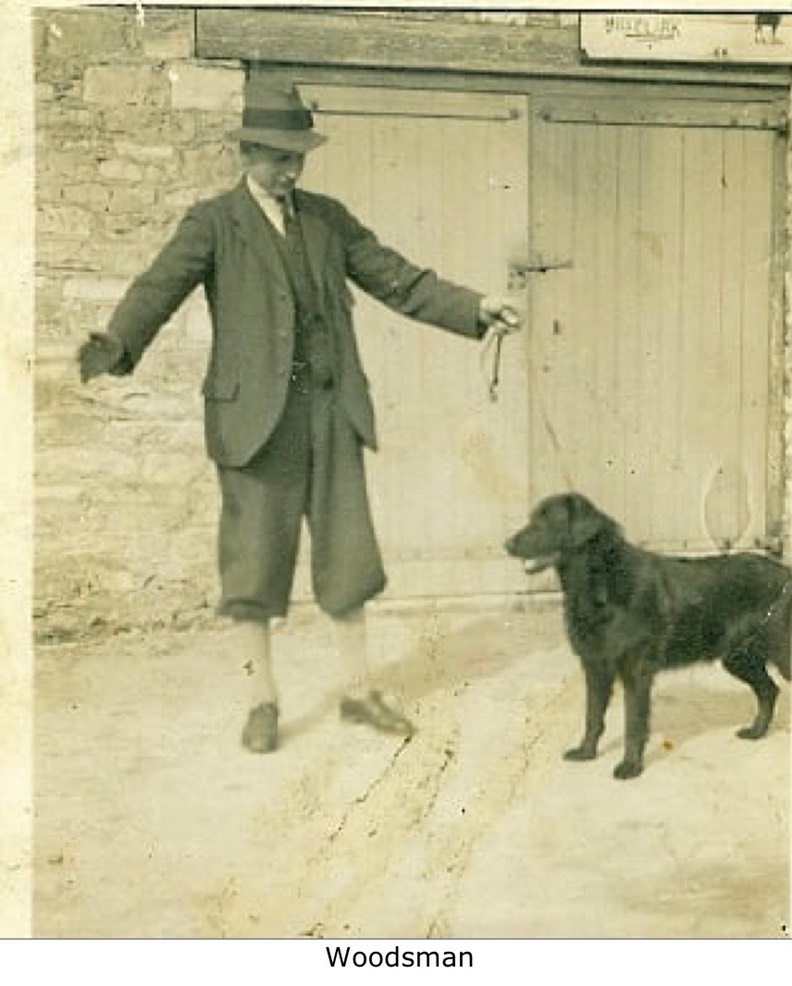
Salthills Special, or Spec, as she was called, was bred by the gamekeeper Will Simms at Ettington Park, the home of the Shirley family. Will's father was the keeper of Sewallis Shirley, at the same estate, the man who is considered to be the founder of the modern Flatcoat. Colin took advantage of Will Simms long experience when it came to gundog breeding.
The most dominant breeder at that time was Reginald Cooke (Riverside). He bought many dogs and offered big money for the best ones. Colin told me he was given an offer he couldn’t refuse by Cooke. He sold the first” W” dog, Woodsman to him, but the dog was never heard of again and there are no traces of him in the contemporary pedigrees. Maybe he wasn’t good enough to breed from after all?
When the second world war started Colin had to abandon his kennel. He was mobilized and went down for six years of army service in West Africa. When the war ended he reestablished himself as a gamekeeper. It was necessary to get new working dogs and he got in touch with Dr Nancy Laughton and started a lifelong and very fruitful collaboration. Dr Laughton, was a newly established breeder, having great success with her first Flatcoat Claverdon Jet. Jet was out of pure working blood, of Welsh origin, on the dam’s side and primarily from show lines on the sire’s. Nancy had obtained the male Revival of Ettington from Will Simms as well who’s dam was bred out of Colins bitch Salthills Special before the war.
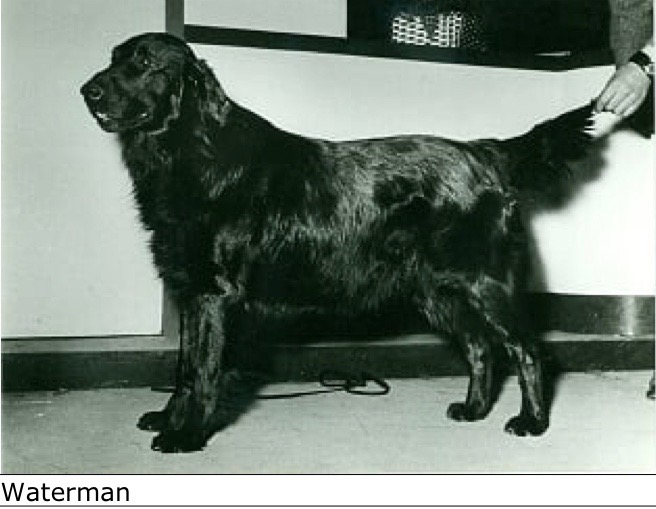
Nancy Laughton had her very first litter out of Revival and Jet. She once told how Wells took his motorbike across England to pick up his new puppy from that litter. He bought a young dog as well from Will Phizaklea (Atherbram), one of the few breeders who was able to maintain a Flatcoat kennel through the war. Wells went to Phizaklea to pick a booked puppy but he saw a young dog in the kennels and asked if he could buy him instead. Wells registered the dog as Waterman and he became the ancestor of a male line that has dominated the show world until today. Waterman had several lines back to the most successful show combination of the thirties out of Dancer of Riverside x Atherbram Jet, which explains his successes. To measure the magnitude of this successful male line Waterman won the most prestigious English dog show Crufts four consecutive years, and his son Workman won immediately thereafter five times in a row. From the beginning of the fifties, most male winners at Crufts, with a handful of exceptions, come in direct male line down from Waterman. Many of the early ones were linebred to Waterboy his son Woodlark and grandson Fenrivers Golden Rod. Later the latter’s son Tonggreen Sparrow Boy became the great “breeding engine”, being targeted for recurrent line breeding.
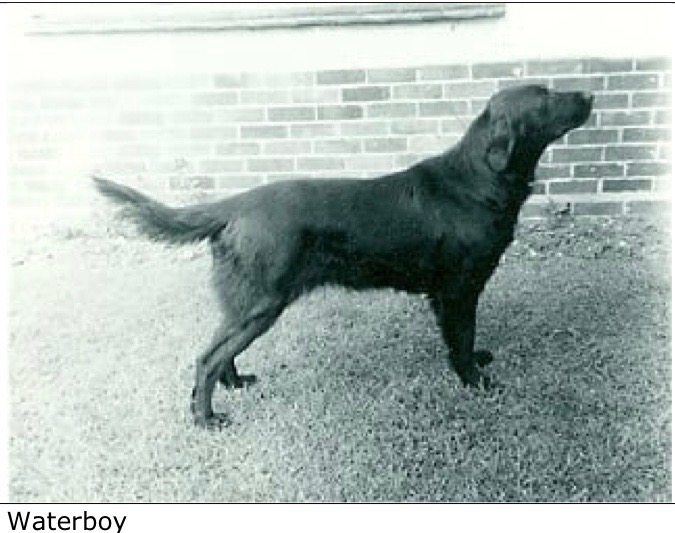
Read Flowers (Fenrivers) had a close contact with Wells over all these years, he bred from many of the ”W” dogs and he linebred extensively to Waterboy. He said in an obituary after Wells death that "Colin had four dogs in the kennel when I got to know him. They were Waterman, Waterboy, Workman and Claverdon Waternymph. I remember Waterman as a wonderful top-class dog. Waterboy and Workman were fallen after Waterman and out of Claverdon Faith. Waterboy was my biggest favorite, he had good legs and body and a wonderful and steady temperament.
He won many prizes at Field Trials over the years. He never developed a full coat, which handicapped him a little at shows but he became the father of many good offspring. I especially remember some of his daughters who had great stamina while being responsive and having good noses and game finding capability. Ch Workman was a great show star and at the same time a good working dog. He had good legs and body and was extremely sound and well balanced. He as well left some very good offspring who could carry on his line.””
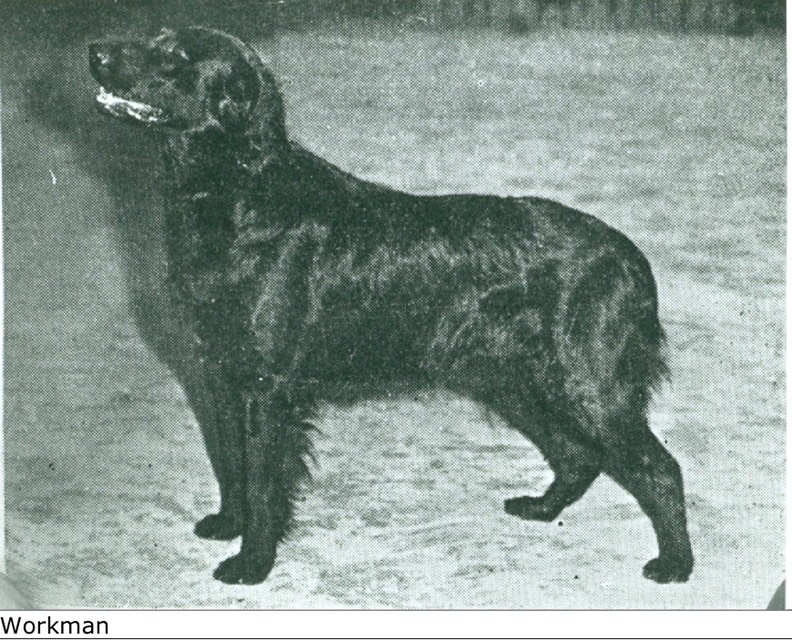
Colin bought Claverdon Tawny Pippet as a brood bitch. She was a first class worker and conquered her show title in no time. She left behind Wave, after Workman 1957, and Woodlark, after Waterboy in 1958. Wave was a dazzling working dog and one of Colin's favorite bitches. She won one of Flatcoated Retriever Societys Field Trials and became the mother of Waveman after Blakeholme Jem. Woodlark was a medium sized dog with amazing type and quality. However, he was not particularly fond of shows and he often paced in the ring. He became a champion at four years of age. He was a great worker, being brave, persistent, biddable with a strong game sense.””
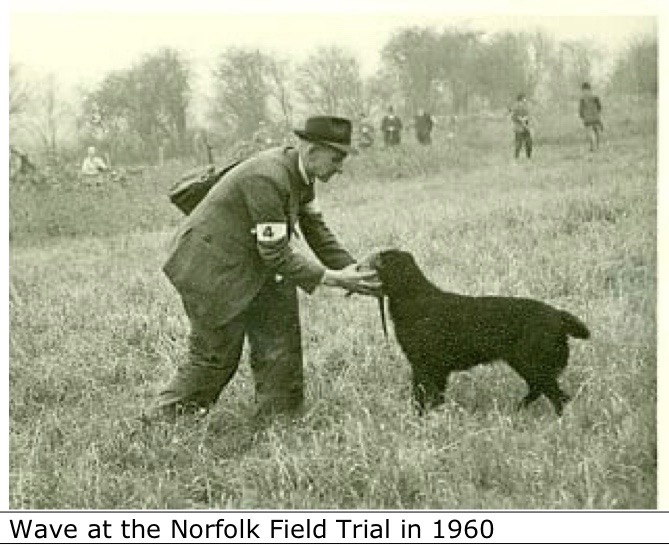
"Woodlark sired many good dogs bringing on his blood line. I especially remember my own Fenrivers Golden Rod and Colins Woodpoppy. I did not get an opportunity to get to know "Poppy" so well but I saw her in the ring and experienced her working at Belvoir and I hold her as my great favorite among Colin's bitches. Among the dogs, I would choose Waterboy. Later, Colin owned Kenstaff Whipster and Woodland Whipcord. Kenstaff Whipster was a good dog and I note that he won two certificates and at least two prices at Field Trials. In the early 1980s, Colin suffered from bad health and was forced to end his dog activities. He gave Whipcord to his son Ron, who succeeded him as headkeeper at Belvoir Castle.””
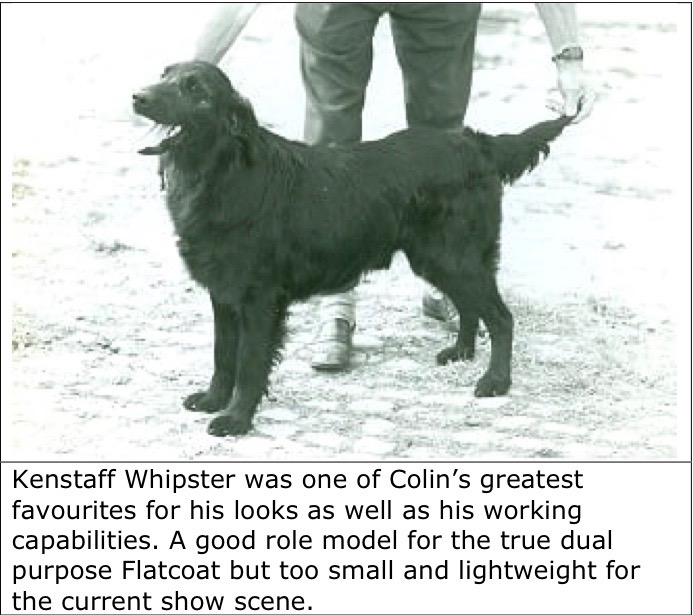
It seems obvious that Waterboy must have been Colin’s great favourite over the years. He had great success in the fifties when he was placed among the top three at the Flat-Coated Retriever Society's All Aged stake seven consecutive years, and he won it twice. He was the only Flatcoat during these years competing successfully at Any Variety Open Stakes and if he had won instead of being second at one of these he would have become a historical dual champion. The demanding gamekeeper job limited his options during the Field Trial season. Furthermore, the versatile work a gamekeeper’s dog is asked to perform can easily spoil the firm obedience needed in a first class Field Trial dog. Colin told how the dogs that were up for competition one season were given carefully selected retrieves at the shots where it could be kept under absolute control, a control that is necessary for success at Field Trials. Waterboy was a great favourite in Flatcoat circles and many of the great names like Read Flowers and Amelia Jessel linebred repeatedly to him. Fenriver's Golden Rod was linebred to him as well as Jessel's FT Champion Werrion Redwing of Collyers.
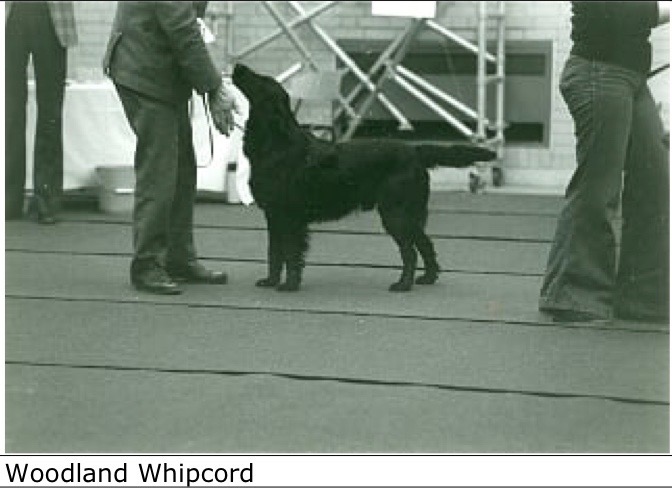
Colin continued to compete his dogs until the eighties and the last winning "W" dog, was Woodland Whipcord with a 2nd at the FCRS (Flat Coated Retriever Society) Novice Stake in 1979 and 3rd at the FCRS All Aged Stake in 1980.
The Flatcoat has a reputation of being a versatile dog and it is probably the reason for it being the gamekeepers dog until modern times and maybe they still are to some extent. The dogs were used to drive or flush game and for cold picking up, that is to search through the grounds to find remaining game after the shots. Colin sold a large share of his pups to other gamekeepers. He was gamekeeper for forty-three years and he spent the last twenty years of his career as the headkeeper at Belvoir Castle, being one of England's greater shots.
To give you an idea about the size of the shot, during his time as headkeeper (the master of the shot), he had four employed underkeepers. Around 10,000 pieces of gamebirds (mostly pheasants) were reared each season and the most successful shooting day could bring close to 900 pheasants. Starting out as a social event for the noble class, the shots gradually became an important source of revenue for the estates where a shooting day could bring in many thousands of pounds. The role of the keeper is to rear the pheasants, to offer good shooting conditions for the guns and to keep away the poachers. The organizational efforts Colin had to make during the shot required dogs that didn’t need that much attention. They must be absolutely quiet and steady, not interfere with the guest’s dogs, easy going and effective to find and pick up game that wasn’t found by the other dogs and persevering enough to stand continuous shooting days that covered most of the week during the season from October to February, It goes without saying that this was an excellent test ground for a working Flatcoat.
Until recently Belvoir Castle (pronounced Beaver Castle) was also renowned for being one of England's greatest fox hunts, the famous Belvoir Hunt, supported by a foxhound pack of around fifty dogs and a number of men running the hunt.
The conformation
Colin looked for
in a Flatcoat deviates quite strongly from today’s fashion. His ideals, founded
in the thirties and refined by a life
long experience of retriever work, was based
on an idea of what favored good style in the
field. The term style
summarizes all the features that
are needed in a shooting dog, how it manage different shooting situations and how it
moves in the field. Colin tried to find
a male being
about 58 cm (23 inch) at the withers, with a comparatively short body and a back supporting
a close
search pattern, with a balance between the chest and the moderately long legs enabling
the
dog to gallop a full working day with perseverance and in a good pace and, finally, with a short and happily wagging tail. He appreciated an intelligent
expression with a very dark brownish eye.
After
visiting one of his very last shows in the early 1980s Colin expressed great concern that many dogs began
to resemble "black Goldens," with a heavy body that wasn’t suited for the kind of work they were supposed to
perform. Colin was unfortunately not a person who easily brought his opinions to the public but I believe it must have been during the seventies
when Nancy Laughton and Colin made
a joint statement at a conference that the
ideal height of a male Flatcoat
should be between 58 –
61 cm. and slightly lower in a female. Pretty soon after a revision of the standard was made and these measures were introduced. A previous
quite significant variation in size could be addressed
to the benefit of the breed as a working
gundog but I presume most could agree that there are still
quite many dogs being far too large for the shooting field.
The impact of the ” W” -line on the Nordic working Flatcoat
The famous Swedish Golden-breeder Mrs Mona Lilliehöök (Apports) has told how she fell in love with the Flatcoat seeing the Christmas add Colin used to publish in Our Dogs during the fifties. It showed Waterman sitting like a black lion king, surrounded by Waterboy, Workman and Claverdon Waternymph. She contacted Mrs Hutton and was given an option to buy Black Penny of Yarlaw in 1962. Penny was sired by Colins Woodlark out of Pewcroft Prop of Yarlaw, sharing BoB and BoS between them at Crufts the same year and they were both first class workers. A year later, Brit-Marie Brulin (of the Puhs Labradors) bought Downstream Hestia from Peter and Shirley Johnson. She was sired by Winkswood out of a Woodlark daughter and thus being another bitch out of the “W” line. They were both mated to Blakeholme Jamie, bringing in a strong Claverdon/Pewcroft line and establishing a blood line that became the backbone of the Flatcoat in the Nordic countries, appearing behind numerous show winners as well as the main shooting lines.
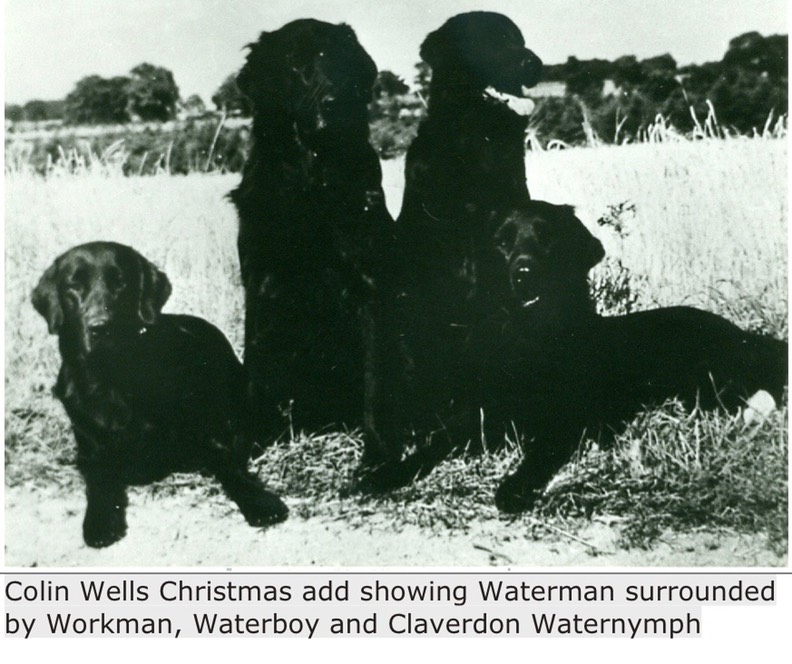
In 1977 Downstream Ambleside Jill was imported by Gunnel Wahlström, of the Gunhill Flatcoats, one of many Downstream Flatcoats having a huge impact on the Swedish Flatcoat. She was sired by Woodway with generations of “W" dogs behind on both sides. Jill was in whelp with Tonggreen Sparrowboy establishing a strong working line with O'Flanagan Free-As-Air and his halfbrother Gunhills Cheiron in the forefront. They are two of the most famous dogs in local working retriever history winning numerous cold game trials as well as the Swedish Retriever championship during the eighties. Another bitch with a strong “W” oriented pedigree, Hovhills Gradely Lass, won the Retriever Championship in 1980, O’Flanagan-Free-As-Air won in 1981, Hovhills Gradely Lass again in 1982 and Gunhills Cheiron in 1983, years that could be considered to be the hey days of the Swedish working Flatcoat.
Cheiron sired one of the most outstanding litters for Stig and Kerstin Olssons Hovhills kennel, producing five dogs getting merits in Elite class of which tree gained the FT Ch title. It may finally be mentioned that Inger Karlssons highly successful litters out of Micawber and Biörkhedens Candlelight (Trygg's Flat x Woodland Wistful) comes from a strong “W” Line on both sides. As it seems the type of dog that Colin looked for was particularly well suited for Swedish shooting conditions. Working abilities exposed by a strong perseverance and drive as well as a strong water passion and biddability.
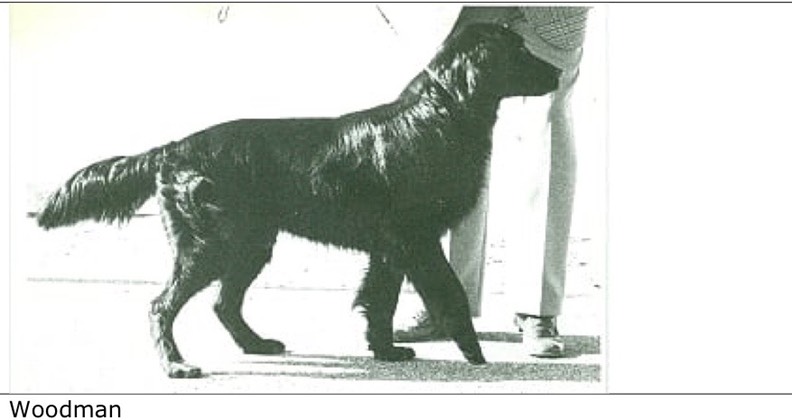
Wood Man was for sure the most famous “W” dog that was sold abroad to a Swedish breeder. He was almost unbeatable in the ring, doing quite good at Swedish cold game trials, being quite heavily used at stud but with a quite poor result. We owned his son, Woodland Wanderer, siring one litter for us producing a winner of the Swedish Flatcoat championship. Our second “W” dog, Woodland Wiseman sired a few litters of which two produced a number of dogs getting high merits in the field. My personal favourite however among his offspring was the Finnish bitch champion Minnies Bluebell, getting high merits at shows but primarily being a first-class worker and the kind of Flatcoat I’m sure would have done well at proper Field Trials given a more experienced handler. Her dam added a number of lines back to Waterboy which probably explains her great capacity. The offspring of Bluebell appears behind the Swedish work oriented Flatterhaft and Lopplådan kennels.
Woodland Wistful and High Leys Scot (being co-bred by Colin and his son Ron) played major roles behind the main Swedish working line with numerous lines back to Waterboy. FT Champions Micawbers Ohanes (the grandson of Hovhills Gradely Lass), his son Kecas Fetisof and grandson Hinnareds Nitro were the most successful working dogs in each generation. The latters daughter Duckstream Cragganmore won the Swedish Flatcoat championship for three consecutive years and was at the top at a number of Any Variety Field Trials. She must be considered to be the best working Flatcoat bitch ever in the Nordic area with an offspring successfully matching her great results under the Norwegian Waternut prefix. Once again with a pedigree heavily dominated by the Waterboy line.
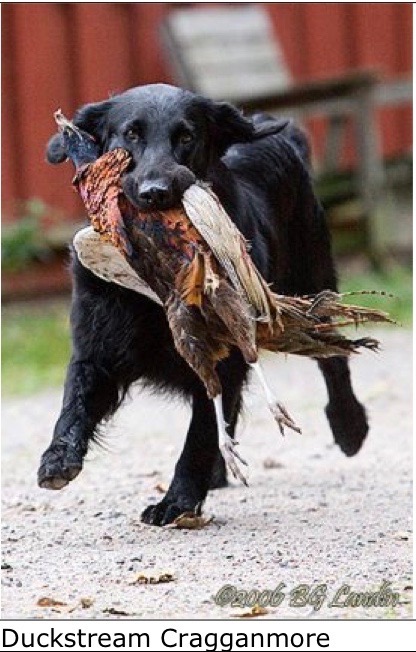
A number of ”W” Flatcoats were exported to Norway with Woodland Whipper-in in the forefront successfully being used by the Brenna and Cariena Kennels. A few “W” dogs were exported to Denmark as well with no major impact on Danish blood lines.
Wells's breeding program is a
brilliant example of how to conserve and enhance good working qualities
through a targeted
breeding on first class working dogs. Wells stuck to the same blood line for
fifty years, by continuously
linebreeding to the Waterboy line and bringing in outcrosses, primarily from
the Claverdon kennels, in every second generation. The impact of this line along with Nancy Laughtons Claverdon
in most
British kennels is huge, which
certainly explains why many of
these could produce good workers, even
though their main
focus was on show features. However, like in other gundog breeds, working capabilities are
diluted and disappears if not checked in every generation.
It is probably practically impossible, with the number of individuals in
the breed today, to repeat
the successes of Colin Wells, Nancy Laughton, Read Flowers and others during the post war period,- with a number of dogs getting high merits in the field
as well as shows. The
British dog culture is second to none and we can be sure that breeders will
continue to produce some of the best Flatcoats in the world. But the
competition is getting harder, not the least from Nordic breeders, and it’s a
fact of life that you have to focus and be extremely determined to reach the
top in any area. I don’t believe we will see a "Colin Wells" or "Nancy Laughton" again in the future but I’m sure there are many breeders around the world
sharing the same ambitions to make the working Flatcoat great again!!